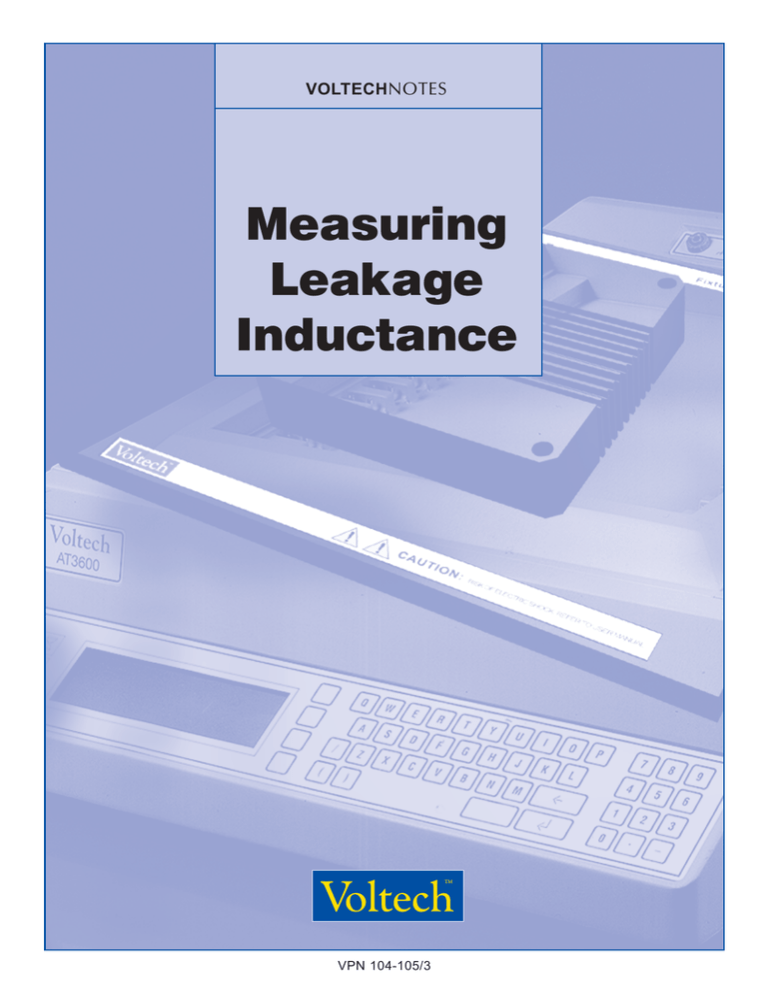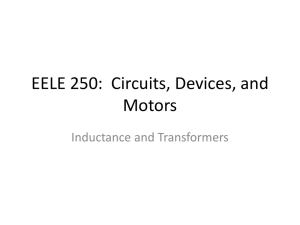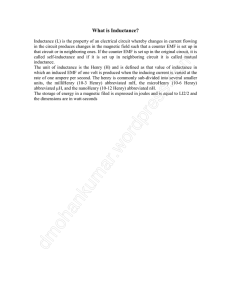
VOLTECHNOTES
Measuring
Leakage
Inductance
VPN 104-105/3
VOLTECHNOTES
WHAT
IS LEAKAGE INDUCTANCE ?
Leakage inductance is an inductive component present in a transformer that results from
the imperfect magnetic linking of one winding to another. Any magnetic flux that does not
link the primary winding to the secondary winding acts as inductive impedance in series
with the primary, therefore this “leakage inductance” is shown on a schematic diagram
as an additional inductance before the primary of an ideal transformer.
In certain applications, such as switched-mode power supplies and lighting ballasts,
leakage inductance of the transformer may play a critical function in the product design.
For this reason, accurate measurement of leakage inductance is often an important test
function for transformer manufacturers. In order to avoid confusion with other transformer
characteristics, this technical note will not refer to other components of loss such as
winding resistance or inter-winding capacitance.
Ideal transformer
For a theoretical, ideal transformer, there are no losses. Voltages are transformed
in the direct ratio of the turns; currents in the inverse ratio of turns (figure 1).
No gap
N1
V1
Windings
Core
N2
V2
Figure 1. Ideal transformer:
V2 = V1 x (N2/N1)
Main flux
Real transformer
In a real transformer, some of the flux in the primary may not link the
secondary winding. This “leakage” flux takes no part in the transformer action
and can be represented as an additional inductive impedance that is in
series with the primary winding (figure 2).
Small
leakage Ideal transformer
inductance
2
Leakage flux is a proportion of the
Main flux total flux, stored in the primary winding
Figure 2. Real transformer showing
unwanted leakage inductance
© 2001 Voltech Instruments. All rights reserved.
VOLTECHNOTES
L EAKAGE INDUCTANCE
Real transformer plus an air gap
In certain transformer designs, leakage inductance must be a greater proportion
of the total inductance and is specified within a tight tolerance. The increased
proportion of leakage inductance is usually achieved by introducing an air gap in
the core design, thus reducing the permeability of the core and therefore the
value of primary inductance. The ratio of flux that does not link the primary
winding to the secondary winding will therefore increase relative to the flux that
links both windings (figure 3).
Large
leakage Ideal transformer
inductance
Main flux
More leakage flux due to
increased gap in core
Figure 3. Real transformer designed with
a gap to provide desired leakage inductance
Why is measurement of leakage inductance
important?
Leakage inductance (LL) may be undesirable in a wound component, in
which case it is important to measure the value to show that it is low or,
in some applications, such as electronic lighting ballasts and resonant
power converters, leakage inductance is deliberately introduced and its
value is an integral part of the circuit design. In these applications, the
leakage inductance provides an energy storage medium that is essential
to achieve correct operation of the finished product. It is therefore important that the value of leakage inductance of the transformer is known to
be within specified limits.
3
© 2001 Voltech Instruments. All rights reserved.
VOLTECHNOTES
L EAKAGE INDUCTANCE
How is leakage inductance measured?
When an LCR meter is connected to the primary winding of a transformer with
open-circuit secondary terminals (figure 4), the value of inductance (L)
comprises primary inductance (LP) plus leakage inductance (LL).
LL
Measured L = LP + LL
10V
2:1
LP
LS
5V
L total = LL + LP
Figure 4. Transformer with open circuit on both primary and secondary
Since LL is a function within the transformer, it is
clearly not possible to measure its value directly.
A method must therefore be used to subtract the
value of LP from the total measured inductance.
This is achieved by applying a short circuit
across the secondary terminals (figure 5). A
perfect short circuit will result in zero volts on the
output terminals (figure 6) and, through transformer action, zero volts will also appear across
the primary inductance. The measured value of
inductance at the primary terminals will therefore be the true leakage inductance (LL).
LL
Measured L = LL
Figure 5. Transformer with
soldered short circuit(s)
2:1
0V LP
LS
Perfect short circuit (0V)
L total = LL
Figure 6. Transformer with perfect short circuit across secondary
4
© 2001 Voltech Instruments. All rights reserved.
VOLTECHNOTES
L EAKAGE INDUCTANCE
Unfortunately, achieving a perfect short circuit on the secondary of a transformer is difficult in a laboratory and completely impractical in a production
environment. In production, it is common for the short circuit to be applied
manually or via a switchable relay. Under these conditions, a perfect short
circuit cannot be achieved, and it follows that the secondary voltage will not
be truly zero. The voltage attributable to the imperfect short circuit will then
appear across the primary inductance as a short-circuit error multiplied by the
turns ratio (figure 7).
N=2
2:1
LL
LTotal = LL+N2Ls/c
Rs/c
2x Vs/c
LP
Short-circuit Voltage
g attributable
impedance to short
h circuit
i i (Vs/c)
Ls/c
LS
Figure 7. Transformer with short-circuit impedance error
Note: turns ratio = 2
Ls/c is reflected in the primary as N 2L s/c because, in any winding, L is proportional
to the number of turns squared (L α N2). Thus, Ls/c is reflected as a function of:
(
(
Np
Ns
2
=
Lp
Ls
The measured value of the primary inductance can be considered vectorially
as the sum of the leakage impedance plus the reflected impedance of the
short-circuit error. This is shown in figure 8.
Voltage attributable to
reflected short-circuit
impedance
Measured voltage on
primary attributable
to leakage impedance
and reflected s/c
impedance
Voltage attributable to
true leakage impedance
Figure 8. Vector diagram showing leakage inductance and short-circuit error
© 2001 Voltech Instruments. All rights reserved.
5
VOLTECHNOTES
L EAKAGE INDUCTANCE
The traditional solution
In order to obtain the true value of leakage inductance, engineers will carefully apply a soldered short circuit to the secondary of the transformer to be
tested and measure the value of inductance on the primary. This value of
inductance will be recorded as the ‘true’ leakage inductance (e.g. 150µH).
The inductance will then be measured on the same transformer after the
soldered short circuit has been replaced by either a shorting clip or a fixture
with relay-operated short circuit, depending on the technique that will be
chosen for production. The measured inductance is again recorded (e.g.
180µH). This value will, of course, be greater than the original because it
includes the true leakage inductance plus the short-circuit error inductance.
The difference between these two values (in our example 30µH) is then
used in production testing as a fixed offset that is programmed into a
production LCR meter to obtain an approximation of the correct value in the
presence of an imperfect short circuit.
In practice, it is impossible to achieve a relay-based or manual-based short
circuit that produces exactly the same short-circuit error every time. This
non-repeatability of short-circuit error is such that the fixed offset cannot
provide a production department with accurate and repeatable results. This
is illustrated in the following table:
True LL
Measured
value
Fixed
offset
Result
Pass/fail
9
8
8
Measurement #1
150µH
180µH
-30µH
150µH
Measurement #2
150µH
200µH
-30µH
170µH
Measurement #3
150µH
205µH
-30µH
175µH
The Voltech solution
Voltech have developed their AT series testers with an architecture and
processing ability to remove the short-circuit error from the primary inductance
measurement during each and every test. This technique is shown vectorially
below using the measured values from the preceding table as an example.
6
From the primary vector diagram, it can be seen that each measurement is the sum
of the voltage attributable to the leakage inductance plus the error voltage from the
secondary short circuit. Before applying a short circuit, the Voltech AT series testers
measure the primary to secondary turns ratio. The testers then automatically apply
a short circuit, using an internal relay matrix, and measure the short-circuit voltage
at the transformer secondary pins. The vector of this short circuit voltage is auto-
© 2001 Voltech Instruments. All rights reserved.
VOLTECHNOTES
L EAKAGE INDUCTANCE
matically multiplied by the turns ratio, producing an 'error vector' that is equal to the
short-circuit error voltage reflected into the primary measurement. The leakage
inductance is then computed from the total primary inductance value less the
primary error vector that has been calculated. This process enables Voltech AT
series testers to provide the true leakage inductance value, irrespective of shortcircuit variability.
Measurement
Turns ratio(2)
x s/c error
Voltage attributable to
true leakage impedance.
This value is given as
the AT Series LL result.
True LL
Short circuit
measurement
Figure 9. Vector diagrams showing measured short-circuit impedance on the secondary winding
True LL
Measured
value
Measurement #1
150µH
180µH
Measurement #2
150µH
200µH
Measurement #3
150µH
205µH
Real-time
vector
compensation
9
9
9
Result
Pass/fail
150µH
9
9
9
150µH
150µH
Conclusion
Leakage inductance is a critical transformer characteristic that presents a particular
measurement challenge to both design and production test engineers. By looking at
the factors effecting measurement integrity and developing innovative measurement
techniques to overcome these factors, Voltech provides a unique solution to a
problem of measurement variability that faces almost all transformer manufacturers.
Should you have questions on any of the other test functions available for the
Voltech AT series transformer testers, please do not hesitate to contact us.
7
© 2001 Voltech Instruments. All rights reserved.
VOLTECHNOTES
Voltech Instruments Ltd.
148 Sixth Street
Harwell International Business Centre
Harwell, Didcot, Oxon OX11 0RA
United Kingdom
Telephone: +44 (0)1235 834555
Facsimile: +44 (0)1235 835016
E-mail: sales@voltech.co.uk
Voltech Instruments Inc.
11637 Kelly Road, Suite 306
Fort Myers, FL 33908
U.S.A.
Telephone: +1 239 437 0494
Facsimile: +1 239 437 3841
E-mail: sales@voltech.com
www.voltech.com
Note: While every care has been taken in compiling the information for this publication, Voltech Instruments cannot accept legal liability for any inaccuracies. Voltech Instruments reserves the right to alter product specifications without notice and whenever necessary
to ensure optimum performance from its product range.
VPN 104-105/3



